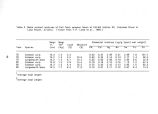| OCR Text |
Show III. 0- Shoreline Water Quality III. D. 1. Statement of the problem. Lake Powell is the most important recreational resource of Glen Canyon National Recreation Area. With 255 square miles of surface and more than 1,800 miles of shoreline, it is the second largest artifical lake in North America, and its clear, high- quality waters offer outstanding recreational opportunities. The management objectives of the recreation area include encouragement of " water- oriented recreation . . . ( and) maintenance of high water quality. . . ." Excessive recreational use, however, can threaten water quality and result in high turbidity and unhealthful levels of pathogenic bacteria. Diseases caused by contaminated recreational waters usually fall into the categories of gastroenteritis and ear, nose, and throat ailments. Since techniques are not available to detect the full range of possible disease- causing organisms in water, the Environmental Protection Agency has established health standards for recreational waters based on the occurrence of easily- monitored fecal coliform bacteria. Presence of these organisms indicates contamination of the water by mammalian feces ( usually human) and the possible presence of pathogens. Arizona and Utah state standards for fecal coliforms in recreational waters are as follows: • Full- body contact: 200 colonies/ 100 mL water ( log mean for 30 days) • Partial- body contact: 1,000 colonies/ 100 mL ( log mean for 30 days) At Lake Powell recreational waters should be kept well within the standard for full body contact ( swimming). In 1975 a problem- assessment study of bacterial contamination was published for Lake Powell ( Kidd 1975). Following lakewide water sampling over several seasons, Kidd found the waters " generally safe for human body contact," although contamination sometimes exceeded state standards. Continued water quality monitoring was recommended. A similar study in 1976 ( Cudney 1977) found water along the shoreline at heavily used sites to have very low bacterial concentrations, and the sanitary quality of the lake was characterized as " excellent," with a few sites in the " good" range. Problem- assessment monitoring was again carried out lakewide in 1985 by Fitzgerald et al. ( 1985). In this study it was found that lake waters generally were of excellent quality, but that individual samples sometimes exceeded the standards at heavily used shoreline sites. At Lone Rock Beach and one or two other sites, the geometric mean of samples was high enough to cause concern about the long- term water quality trend, although the figures were well within the legal standards ( 127 coliforms per 100 mL at Lone Rock, the site with the highest value). Based on these studies it is believed that water quality 29 |








































































































